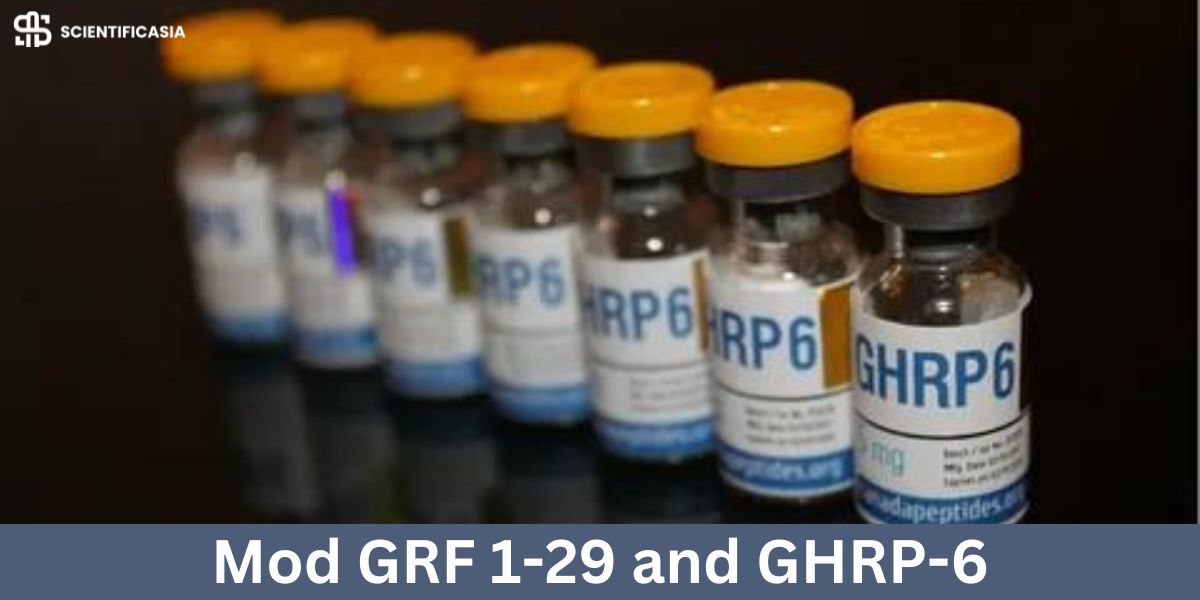Mod GRF 1-29 and GHRP-6 are synthetic peptides often discussed in growth hormone research. Mod GRF 1-29, also known as Modified Growth Releasing Factor 1-29, is an analog of growth hormone-releasing hormone (GHRH) designed to stimulate growth hormone (GH) release. GHRP-6, or Growth Hormone hormone-releasing peptide-6, belongs to a class of peptides that have been hypothesized to stimulate the secretion of GH through different mechanisms than GHRH analogs. This article explores the speculative mechanisms, potential interactions, and hypothesized properties of Mod GRF 1-29 and GHRP-6.
Mod GRF 1-29 and GHRP-6: Introduction
Growth hormone (GH) appears to play a crucial role in various physiological processes, including growth, metabolism, and cellular repair. The regulation of GH secretion is complex, involving multiple factors and pathways. Synthetic peptides such as Mod GRF 1-29 and GHRP-6 are particularly interesting among the regulatory agents. These peptides might offer insights into novel approaches for manipulating GH release. Mod GRF 1-29 is a modified form of the natural GHRH designed to enhance stability and bioactivity. GHRP-6, on the other hand, is a member of the growth hormone-releasing peptides (GHRPs), which are believed to act through ghrelin receptors to induce GH release.
Mod GRF 1-29: Structure and Speculative Functions
Mod GRF 1-29 is an analog of the first 29 amino acids of GHRH, with specific modifications aimed at improving its pharmacokinetic profile. It has been hypothesized that these modifications may enhance resistance to enzymatic degradation, thereby increasing its half-life and influence in stimulating GH secretion. Research suggests that Mod GRF 1-29 might interact with GHRH receptors on pituitary somatotrophs, increasing cyclic adenosine monophosphate (cAMP) levels and promoting GH release.
GHRP-6: Mechanisms and Theorized Interactions
Studies suggest that GHRP-6 is a hexapeptide that may stimulate GH release through a pathway different from GHRH analogs like Mod GRF 1-29. GHRP-6 is thought to bind to the ghrelin receptor (growth hormone secretagogue receptor, GHS-R) on pituitary cells and hypothalamic neurons. This binding might increase intracellular calcium ion concentration, triggering GH secretion. Additionally, GHRP-6 is theorized to affect the hypothalamus, potentially leading to increased GHRH release and decreased somatostatin (a GH-inhibitory hormone) activity.
Mod GRF 1-29 and GHRP-6: Potential Synergistic Impacts
There is a growing interest in the potential synergistic impacts of using Mod GRF 1-29 and GHRP-6 in combination. Theoretically, combining these peptides might result in a more pronounced GH release due to their complementary mechanisms of action. Research indicates that Mod GRF 1-29 might provide a sustained stimulation of GH release through its interaction with GHRH receptors. At the same time, GHRP-6 is believed to potentiate this result by simultaneously activating the ghrelin receptor pathway and modulating hypothalamic hormone levels.
Mod GRF 1-29 and GHRP-6: Metabolic Implications
The speculative properties of Mod GRF 1-29 and GHRP-6 extend to various metabolic processes. GH appears to play a role in lipid metabolism, promoting lipolysis and reducing fat accumulation. It has been hypothesized that Mod GRF 1-29 and GHRP-6 might enhance these effects by increasing endogenous GH levels. This might potentially lead to improved fat utilization and energy expenditure.
Furthermore, GH appears to influence carbohydrate metabolism by affecting insulin sensitivity and tissue glucose uptake. Research indicates that Mod GRF 1-29 and GHRP-6 might contribute to these processes by modulating GH release, which might impact insulin-like growth factor 1 (IGF-1) levels and signaling pathways.
Mod GRF 1-29 and GHRP-6: Musculoskeletal and Cellular Implications
GH appears to play a critical role in musculoskeletal function cellular repair and molecular mechanisms. It has been theorized that Mod GRF 1-29 and GHRP-6 might support these functions through enhanced GH secretion. GH stimulates the production of IGF-1, which is involved in muscle growth, bone density maintenance, and tissue repair. By increasing GH and, subsequently, IGF-1 levels, these peptides might potentially aid in musculoskeletal development and injury recovery.
Mod GRF 1-29 and GHRP-6: Neuroprotection
Emerging research suggests that GH and IGF-1 may have neuroprotective properties. These hormones are believed to support neuronal growth, survival, and differentiation. Investigations purport that Mod GRF 1-29 and GHRP-6, through their GH-releasing activities, might influence these neuroprotective impacts. It has been hypothesized that enhanced GH secretion might contribute to cognitive functions and neural function, potentially offering avenues for exploring approaches for neurodegenerative conditions.
Mod GRF 1-29 and GHRP-6: Immunity
GH has been implicated in regulating the immune system. It appears to influence the proliferation and function of various immune cells. Findings imply that Mod GRF 1-29 and GHRP-6 might exhibit immunomodulatory properties by increasing GH levels. Research indicates these peptides might enhance immune responses, aiding certain immunocompromised states or conditions requiring immune system support.
Mod GRF 1-29 and GHRP-6: Conclusion
Mod GRF 1-29 and GHRP-6 are intriguing synthetic peptides with speculative implications in regulating growth hormone release. Also, Mod GRF 1-29, enhanced stability and affinity for GHRH receptors, and GHRP-6, with its unique ghrelin receptor-mediated pathway, represent potential tools for investigating GH-related functions and approaches. The hypothesized synergistic impacts of combining these peptides and their potential implications in metabolism, musculoskeletal function, neuroprotection, and immunomodulation warrant further research. While the theoretical properties are promising, rigorous investigations are necessary to elucidate the full scope of their mechanisms and implications.
Buy Mod GRF 1-29 & GHRP-6 if you are a licensed individual interested in further studying the potential of these peptides.
Read more:
Side Effect of Ozempic: Are You at Risk
Sermorelin and Ipamorelin Blend in Organism Research
References
[i] Pombo M, Leal-Cerro A, Barreiro J, Peñalva A, Peino R, Mallo F, Dieguez C, Casanueva FF. Growth hormone releasing hexapeptide-6 (GHRP-6) test in the diagnosis of GH-deficiency. J Pediatr Endocrinol Metab. 1996 Jun;9 Suppl 3:333-8. PMID: 8887178.
[ii] Yu AP, Pei XM, Sin TK, Yip SP, Yung BY, Chan LW, Wong CS, Siu PM. [D-Lys3]-GHRP-6 exhibits pro-autophagic effects on skeletal muscle. Mol Cell Endocrinol. 2015 Feb 5;401:155-64. doi: 10.1016/j.mce.2014.09.031. Epub 2014 Oct 29. PMID: 25450862.
[iii] Oliveira JH, Vieira JG, Abucham J, Lengyel AM. GHRP-6 is able to stimulate cortisol and ACTH release in patients with Cushing’s disease: comparison with DDAVP. J Endocrinol Invest. 2003 Mar;26(3):230-5. doi: 10.1007/BF03345162. PMID: 12809173.
[iv] Vittone, J., Blackman, M. R., Busby-Whitehead, J., Tsiao, C., Stewart, K. J., Tobin, J., Stevens, T., Bellantoni, M. F., Rogers, M. A., Baumann, G., Roth, J., Harman, S. M., & Spencer, R. G. (1997). Effects of single nightly injections of growth hormone-releasing hormone (GHRH 1-29) in functiony elderly men. Metabolism: clinical and experimental, 46(1), 89–96. https://doi.org/10.1016/s0026-0495(97)90174-8
[v] Sinha, D. K., Balasubramanian, A., Tatem, A. J., Rivera-Mirabal, J., Yu, J., Kovac, J., Pastuszak, A. W., & Lipshultz, L. I. (2020). Beyond the androgen receptor: the role of growth hormone secretagogues in the modern management of body composition in hypogonadal males. Translational andrology and urology, 9(Suppl 2), S149–S159. https://doi.org/10.21037/tau.2019.11.30
















